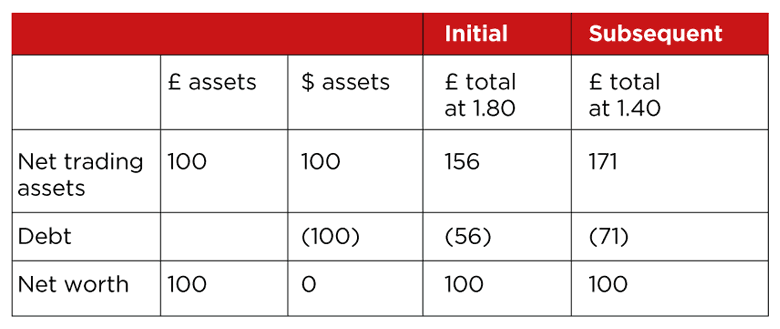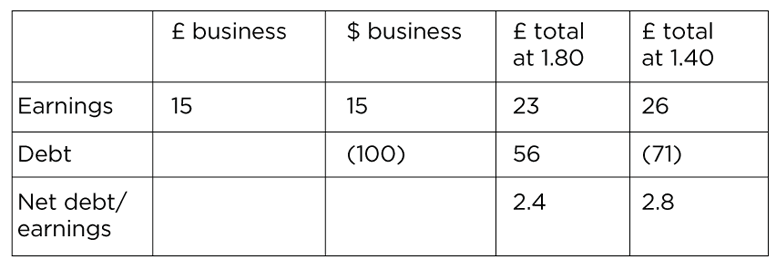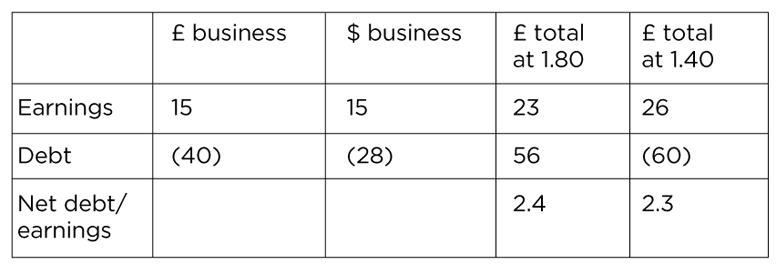
Translation risk is one of several types of FX risk, including pre-transaction, transaction and economic risk. It arises from having trading companies or branches located overseas, or a company or branch trading completely in a foreign currency, and is therefore a risk of ownership as opposed to a risk of trading.
One feature of this risk is that it only arises when consolidated financial statements are drawn up (for whatever purpose) and so one dollar of income one year is worth something different to one dollar of income the following year when consolidated (and translated) into sterling (or euros, etc) as the exchange rate used (an average for income) will almost certainly be different for the two periods. The risk extends to translation of assets and liabilities as well as income and, in that case, closing exchange rates are used. It is often seen as a non-cash risk.
Economically, this is a risk that investors normally accept because the risk implies multi-currency earnings on a large and diverse scale, which they usually like. The income aspect of the risk is therefore rarely hedged and typically the currency effect on sales and profit changes are stripped out in any investor presentations.
Translation risk can affect the profit and loss account, balance sheet and cash flow statements, which are the foundation of the ratios on which credit ratings, loan covenants and credit fundamentals are based. Indeed, a company might breach a covenant or suffer a downgrade purely as a result of movements in currency.
Consider a UK business with no gearing that decides to acquire a US-based business and takes on US dollar debt to pay for it. The following example shows this, with a consolidation at two different exchange rates, a starting rate of 1.80 and a subsequent rate of 1.40:

Net worth does not change on consolidation and so it looks like we have a perfect hedge for translation risk. Indeed, we have found a ‘net investment hedge’ as described in accounting standards. But these seem to have pointed managers into net investment hedging at the expense of the fundamentals, as we can see if we consider the impact on earnings:

With the strengthening of the US dollar, earnings have risen, but a credit measure has worsened, which might cause a covenant to be breached or a credit rating to be notched down.
The approach of financing foreign investments with debt of the same currency is a very common one, but in this example a full hedge of the assets is probably the wrong approach and very risky. In our example, a better approach may be to spread the debt required for the acquisition between the two currencies. In the following example, the debt was split when the exchange rate was 1.80:

In this case, the rise in earnings is accompanied by an improvement in the credit measure – perhaps not enough to gain a notch, but the whole approach is less risky.
We can see similar effects with other credit measures such as interest cover and gearing, and the effect will also have an impact on cash flow measures, all of which should be monitored by a good treasurer.
An additional effect of having debt in local currency is that the interest charge can reduce the translation risk in earnings. When extended to cash flow, however, the situation becomes more complex because some countries may require investment and so will not be generating cash against which to offset interest expense.
Taking on debt in different currencies in this portfolio-type approach to translation risk does require there to be an availability of debt in the markets, bank or otherwise. Of course, debt is difficult to find in many currencies or may be very expensive, either by underlying rate or margin. In that case, this approach is more difficult.
The treasurer needs to work out what is important to their organisation before taking an approach to translation risk. If credit measures or covenants are important, then this approach may be best. But if the concern around those is lower and the focus is on earnings, then a different approach may be best, perhaps funding in the lowest interest rate currencies. Whichever approach is adopted, the risk on all measures – not just earnings – must be fully assessed.
Will Spinney is associate director of education at the ACT
